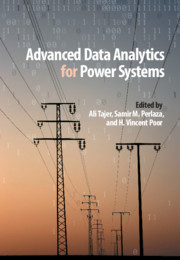14 results
Part IV - Signal Processing
-
- Book:
- Advanced Data Analytics for Power Systems
- Published online:
- 22 March 2021
- Print publication:
- 08 April 2021, pp 283-284
-
- Chapter
- Export citation
List of Contributors
-
- Book:
- Advanced Data Analytics for Power Systems
- Published online:
- 22 March 2021
- Print publication:
- 08 April 2021, pp xvi-xx
-
- Chapter
- Export citation
Index
-
- Book:
- Advanced Data Analytics for Power Systems
- Published online:
- 22 March 2021
- Print publication:
- 08 April 2021, pp 571-578
-
- Chapter
- Export citation
6 - Active Sensing for Quickest Anomaly Detection
- from Part II - Data-Driven Anomaly Detection
-
-
- Book:
- Advanced Data Analytics for Power Systems
- Published online:
- 22 March 2021
- Print publication:
- 08 April 2021, pp 124-143
-
- Chapter
- Export citation
Frontmatter
-
- Book:
- Advanced Data Analytics for Power Systems
- Published online:
- 22 March 2021
- Print publication:
- 08 April 2021, pp i-iv
-
- Chapter
- Export citation
Part VI - Game Theory
-
- Book:
- Advanced Data Analytics for Power Systems
- Published online:
- 22 March 2021
- Print publication:
- 08 April 2021, pp 481-482
-
- Chapter
- Export citation
Preface
-
- Book:
- Advanced Data Analytics for Power Systems
- Published online:
- 22 March 2021
- Print publication:
- 08 April 2021, pp xxi-xxii
-
- Chapter
- Export citation
Contents
-
- Book:
- Advanced Data Analytics for Power Systems
- Published online:
- 22 March 2021
- Print publication:
- 08 April 2021, pp v-xv
-
- Chapter
- Export citation
Part I - Statistical Learning
-
- Book:
- Advanced Data Analytics for Power Systems
- Published online:
- 22 March 2021
- Print publication:
- 08 April 2021, pp 1-2
-
- Chapter
- Export citation
Part III - Data Quality, Integrity, and Privacy
-
- Book:
- Advanced Data Analytics for Power Systems
- Published online:
- 22 March 2021
- Print publication:
- 08 April 2021, pp 195-196
-
- Chapter
- Export citation
Part II - Data-Driven Anomaly Detection
-
- Book:
- Advanced Data Analytics for Power Systems
- Published online:
- 22 March 2021
- Print publication:
- 08 April 2021, pp 99-100
-
- Chapter
- Export citation
Part V - Large-Scale Optimization
-
- Book:
- Advanced Data Analytics for Power Systems
- Published online:
- 22 March 2021
- Print publication:
- 08 April 2021, pp 361-362
-
- Chapter
- Export citation

Advanced Data Analytics for Power Systems
-
- Published online:
- 22 March 2021
- Print publication:
- 08 April 2021
8 - Distributed state estimation: a learning-based framework
- from Part II - Physical data communications, access, detection, and estimation techniques for smart grid
-
-
- Book:
- Smart Grid Communications and Networking
- Published online:
- 05 January 2013
- Print publication:
- 24 May 2012, pp 191-202
-
- Chapter
- Export citation



